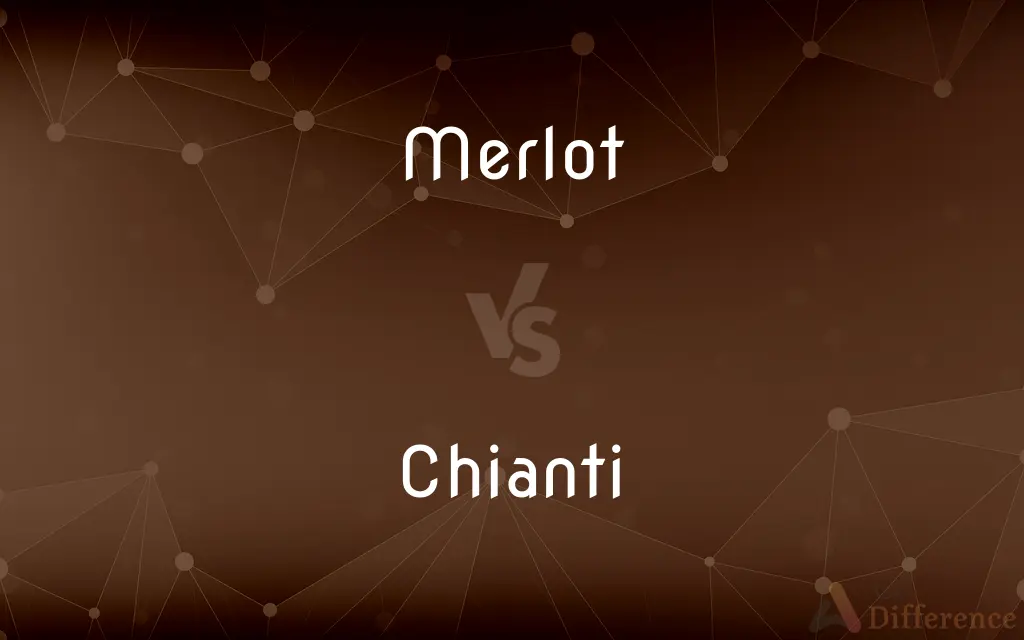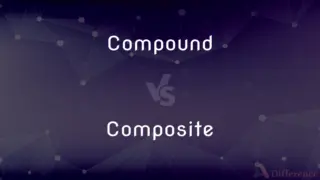Merlot vs. Chianti — What's the Difference?
Edited by Tayyaba Rehman — By Maham Liaqat — Updated on March 29, 2024
Merlot is a smooth, fruity red wine grape variety, popular for its soft, velvety texture and approachability, while Chianti is a red wine from Tuscany, Italy, known for its bright acidity, savory flavors, and firm tannins.

Difference Between Merlot and Chianti
Table of Contents
ADVERTISEMENT
Key Differences
Merlot, a single grape variety, is known for producing wines that are rich in berry flavors, such as black cherry and plum, often with notes of chocolate and herbs. This variety thrives in both cool and warm climates, affecting the wine's character. Chianti, on the other hand, is not a grape but a wine made primarily from Sangiovese grapes, characterized by its high acidity and rustic, earthy notes, often accompanied by cherry flavors and spicy nuances.
While Merlot is appreciated for its softness and roundness, making it an excellent choice for those new to red wines, Chianti is celebrated for its ability to complement food, thanks to its acidity and structure. This makes Chianti a go-to wine for pairing with a wide range of dishes, particularly Italian cuisine like pasta with tomato-based sauces.
Merlot wines are versatile, with styles ranging from easy-drinking, everyday wines to complex, age-worthy examples, depending on the region and winemaking practices. The cooler climate versions are more structured and have higher acidity, while warmer climates produce fuller-bodied, fruitier wines. Conversely, Chianti is typically categorized into various quality levels, including Chianti Classico, Chianti Classico Riserva, and Chianti Superiore, each with specific regulations regarding grape sourcing, aging, and quality, reflecting the wine's complexity and aging potential.
In terms of aging, Merlot can be enjoyed young, offering a pleasing experience without the need for extended aging. However, top-quality Merlots can also benefit from aging, developing more complex flavors over time. Chianti, particularly the higher-quality tiers, has excellent aging potential, with the ability to develop more nuanced flavors and soften its tannins over time, enhancing its compatibility with food.
The global appreciation of Merlot has led to widespread planting and production across various wine regions, making it accessible and enjoyed worldwide. Chianti, while also internationally recognized, carries with it a sense of place and tradition, embodying the essence of Tuscan winemaking and the Italian way of life, which includes a strong emphasis on food and wine harmony.
ADVERTISEMENT
Comparison Chart
Type
Red wine grape variety.
Red wine from Tuscany, Italy.
Flavor Profile
Soft, velvety, with berry flavors like black cherry and plum.
Bright acidity, savory flavors, cherry, and spicy nuances.
Ideal For
Those new to red wines due to its approachability.
Pairing with food, especially Italian cuisine.
Climate
Thrives in both cool and warm climates.
Primarily grown in the Tuscan region of Italy.
Aging Potential
Enjoyable young but can benefit from aging.
High-quality Chiantis have excellent aging potential.
Wine Styles
Ranges from easy-drinking to complex, age-worthy examples.
Includes Chianti Classico, Riserva, and Superiore categories.
Food Pairing
Versatile, pairs well with a variety of dishes.
Ideal with pasta, meats, and cheese, reflecting Tuscan cuisine.
Compare with Definitions
Merlot
A red wine grape known for its soft, velvety texture and fruity flavors.
The Merlot offered notes of ripe plum and a hint of chocolate on the palate.
Chianti
A red wine from Tuscany made primarily from Sangiovese grapes, known for its acidity and savory flavors.
The Chianti, vibrant with acidity, showcased flavors of tart cherry and a touch of earthiness.
Merlot
Widely planted and appreciated for its approachability and versatility.
Merlot, with its broad appeal, is a staple in many wine collections.
Chianti
Classified into quality tiers, including Chianti Classico and Chianti Classico Riserva.
The Chianti Classico Riserva, aged longer, offered complexity and a richer taste experience.
Merlot
Can be enjoyed young, showcasing its fruity, smooth character.
The young Merlot was immediately enjoyable, displaying lush fruitiness and soft tannins.
Chianti
Pairs excellently with food, especially traditional Italian dishes.
Paired with a tomato-based pasta, the Chianti's acidity balanced the dish's richness perfectly.
Merlot
Produces wines that range from medium to full-bodied, influenced by climate.
The Merlot from the warmer region was notably fuller and richer in taste.
Chianti
Reflects the Tuscan terroir, embodying the region's winemaking traditions.
The Chianti spoke of its Tuscan roots, from the sun-drenched vineyards to the artisanal winemaking techniques.
Merlot
Often used in blends to add softness and fruitiness to the wine.
Blended with Cabernet Sauvignon, the Merlot added a smooth texture and depth of fruit.
Chianti
Has the potential to age and develop more nuanced flavors.
With age, the Chianti developed softer tannins and deeper flavors of spice and fruit.
Merlot
Merlot is a dark blue–colored wine grape variety, that is used as both a blending grape and for varietal wines. The name Merlot is thought to be a diminutive of merle, the French name for the blackbird, probably a reference to the color of the grape.
Chianti
A Chianti wine (, also US: , Italian: [ˈkjanti]) is any wine produced in the Chianti region of central Tuscany. It was historically associated with a squat bottle enclosed in a straw basket, called a fiasco ("flask"; pl.
Merlot
A variety of grape originally grown in the Bordeaux region of France that is used to make red wine.
Chianti
A dry red table wine made from a blend of different varieties of grapes, originally produced in northwest Italy.
Merlot
A dry red wine made from this grape.
Chianti
Alternative case form of Chianti
Merlot
Black wine grape originally from the region of Bordeaux
Chianti
A dry red Italian table wine from the Chianti region of Tuscany.
Merlot
Dry red wine made from a grape grown widely in Bordeaux and California
Chianti
Dry red Italian table wine from the Chianti region of Tuscany
Common Curiosities
Are there different styles of Merlot and Chianti?
Yes, Merlot can range from easy-drinking to complex, and Chianti is categorized into quality levels like Classico and Riserva, indicating style and aging potential.
Can Merlot and Chianti be aged?
Yes, both can be aged. High-quality Merlots develop complexity over time, while Chianti, especially in its higher tiers, becomes more nuanced with age.
Can Merlot be found in both single-varietal and blended wines?
Yes, Merlot is popular both as a single-varietal wine and as a key component in blends, adding softness and fruitiness to the wine.
How do climate and terroir affect Merlot and Chianti differently?
Merlot's character can vary significantly with climate, from soft and fruity in warm regions to more structured and acidic in cool climates. Chianti's character is deeply influenced by the Tuscan terroir, promoting a specific profile of acidity and savory notes.
What is the key to Chianti's unique flavor profile?
The Sangiovese grape, along with the Tuscan climate and soil, contribute to Chianti's unique combination of acidity, tannins, and savory fruit flavors.
What food pairs well with Merlot?
Merlot pairs well with a variety of foods, including grilled meats, vegetables, and dishes with rich sauces, thanks to its balance of fruit and softness.
Is Chianti always made from 100% Sangiovese grapes?
No, while Sangiovese is the dominant grape, Chianti can include other varieties, but regulations specify minimum percentages for Sangiovese.
What are some common descriptors for Merlot's flavor profile?
Merlot is often described as having flavors of plum, cherry, chocolate, and herbs, with a smooth and velvety texture.
What makes Merlot a popular choice for wine beginners?
Its smooth, velvety texture and fruity flavors make it approachable and enjoyable without the need for extensive aging.
Why is Chianti particularly noted for its food pairing abilities?
Its bright acidity and savory flavors complement a wide range of dishes, particularly enhancing the flavors of Italian cuisine.
What role does the terroir play in the flavor profiles of Merlot and Chianti?
Terroir significantly influences the flavor profiles, with Merlot reflecting the diversity of regions it's planted in, and Chianti embodying the specific environmental and cultural elements of Tuscany.
How does the aging potential of Chianti influence its taste over time?
As Chianti ages, it can develop softer tannins and more complex flavors of fruit, spice, and earthy notes, enhancing its depth and compatibility with food.
Why might someone choose a Chianti over a Merlot, or vice versa?
The choice could depend on personal taste preferences, food pairings, or the desire for a wine that reflects the characteristics of its region of origin.
How do the aging requirements differ between Merlot and Chianti?
Merlot is often more accessible in its youth, while Chianti, particularly higher-quality versions, benefits from and sometimes requires aging to reach its full potential.
What distinguishes Chianti Classico from other Chianti wines?
Chianti Classico is made from grapes grown in the most strictly defined area within the Chianti region, often showcasing higher quality and greater aging potential.
Share Your Discovery

Previous Comparison
Elixir vs. Solution
Next Comparison
Compound vs. CompositeAuthor Spotlight
Written by
Maham LiaqatEdited by
Tayyaba RehmanTayyaba Rehman is a distinguished writer, currently serving as a primary contributor to askdifference.com. As a researcher in semantics and etymology, Tayyaba's passion for the complexity of languages and their distinctions has found a perfect home on the platform. Tayyaba delves into the intricacies of language, distinguishing between commonly confused words and phrases, thereby providing clarity for readers worldwide.
















































